#angolan cinema
Text

Sambizanga, Sarah Maldoror
#sambizanga#sarah maldoror#1972#1970s#70s#angola#angolan#lingala#africa#movie#film#cinema#cinematography#screencaps#stills
7 notes
·
View notes
Text

Cinema Lusofonia in Periferia. Cinema Lusofonia in Periphery
Cinema Lusofonia in Periferia
Angolan filmmaker Aristides Filipe Pedro, known for the film 'Assalto em Luanda', was recently in Brazil in search of new partnerships in the film industry. During his stay, he had the chance to meet and work with young people from the outskirts of the northern zone of São Paulo, more specifically in Favela do Flamengo.
#news#culture#tumblr milestone#life#showmusic#artistic#film#cinema#Angolan filmmaker#Periphery#periferia#Lusofonia
0 notes
Text
WANNA LEARN SOME HISTORY???
Cool because I have a test tomorrow and I want to write abt it >:3
So let's say we are in the beautiful year of 1870. You are a germanic state trying to unite to other germanic states so you can form a massive empire.
Now let's say you are France. You see a powerful nation being born and decide " Well that's threatening " So you know what you have to do: boicot it ofc
But then they realise what you have been trying to do and invade your country as revenge. They do it with ease, and they go to your simbol of power in Paris, The Versalles (idk how to write that in English lol) and establish themselves as a nation: The Germanic-Prussian empire (again, the term in portuguese I think is "Império Germânico-Prussiano" and Idk how that translates.) And then just leave, but keeping a little part of your country with them. ( portugues expression incoming- Uma espinha entalhada no orgulho francês)
So after that there is a ton of peace and cultural flourishment, in am epoque designated for "Belle Èpoquè" in wich there is like a looot of beautiful things. Let's say the social side of it. People started having more fun since they worked less and the middle class was emerging rapidly. The cinemas, Caffès, operas, theatres, films/movies, amusement parks, all were created at this time. Also penicillin, as they were ton of medical advances at that time. They created the telefone and the plane and the car and WOW everything is beautiful.
In art we see two main themes -> women and nature (often together). Details are suuuuuper important. Clothes get more baloney and plain, with big puff shoulders that were so big that they had to be stored with pillows inside in order not to lose shape. Buildings are BEAUTIFUL and everything is really. It's a great time for humans.
Then people start to get greedy. Africa, still unexplored in its interior is object of many country's desire. They are 5 main countrys who had colonies before: Portugal, Spain, England, France and Holland. 3 new countries want to have some colonies too: Italy, Germany and Belgium.
In 1885 a conference is hosted in Berlim to divide Africa between European countries, being two main things that are considered:
Historical right- given to the 5 starters for beig there the longest/ already having stuff there
Ocupation right- If the country is willing to explore, populate, and take care of that area. The ones who got the most following this right are the 3 big rich countries: England, France and Germany.
Overall the ocuparion right is prioritized, so Portugal comes up with The Pink Map ( no specific reason for the name it was just the color lmao), wich claims to Portugal the lands between the Angolan and Mozambican coast. This is approved.
BUT the English ofc wanted to build a giant train line that connected Cairo and Cape Town, so they needed our ( Portugal's )territory, and since they had like massive belic power the got us and Ultimatum, so that we either leaved or got into war. The king at the time, D. Carlos gave in and England NEVER MADE THE TRAIN LINE WHAT OMG.
Yeyeyey ty for reading this big history lesson bubye!!!
WISH ME LUCK ON MY TEST <3
#guess-ill-dye#history#histoire#history facts#test#<3#rant post#infodump#information#belle epoque#art noveau#art#history addict#<3333333333333333333333333333
11 notes
·
View notes
Text
One Movie From Every Country pt. 8
Today (Sept. 12) is my birthday woahhh!!! Anyway, I a few days ago I watched a film from Angola (and interestingly, the first film in Lusophone Africa) 1972's Sambizanga by director Sarah Maldoror.

The movie is about Maria, wife to revolutionary Domingos Xavier during the Angolan War of Independence from the Portuguese. One morning, out of the blue, Domingos is kidnapped and arrested by Angolan police. Maria, along with their infant child, go from prison to prison trying to find out what happened to Domingos, unknowing to his revolutionary ways and the circumstances of his arrest.
This movie, for many reasons, is very historical and culturally relevant. In a time when African cinema was starting to come into it's own post independence from colonialist rule, a film directed and produced purely in Africa (by a woman, no less) is a feat worth recognizing and admiring. Not to mention that the film, about the Angolan War for Independence, was shot during the war itself. An extremely brave and jawdropping accomplishment.
Though, admittedly profound circumstances aside, I thought the film itself was just alright. While interesting for someone who really knows nothing about Angolan history, it really felt one note and repetitive. Maria getting turned away from police stations, Domingos getting tortured, other MPLA members discuss a man getting arrested, repeat for an hour and a half. It made my experience of a shorter film feel just a bit longer than anticipated.
Like I said, extremely noteworthy film, and not at all a bad debut from an entire country. But unless you're interested in film history or Angolan history, I wouldn't necessarily recommend watching it.
6/10


0 notes
Photo








Women in Film Challenge 2020: [68/52] Sambizanga, dir. Sarah Maldoror (Angola/France/Republic of Congo, 1972)
Day after day new pains are added to our mutual suffering: hunger in our homes, poverty in our huts, forced labor on the road gangs. All this is due to Portuguese colonialism.
87 notes
·
View notes
Photo

Third Language.
With her debut film Farewell Amor out now following a successful journey on the festival circuit, Tanzanian-American writer and director Ekwa Msangi tells Selome Hailu about the third language of music, growing up on knockoffs of the Rambo franchise, and her favorite African filmmakers.
There’s a subtle musicality central to the way Ekwa Msangi carries herself. She finds melodies in her words: “You hum the ‘m’,” she says when asked how to pronounce her last name. “Mmm-sangi.” And perhaps to a more subconscious degree, she speaks with rhythm, too: “I do think, and I know, and I can see…” she trails off, ruminating on how much hope she feels for the future of Black filmmaking. Naturally, this musical quality meanders into her work.
Farewell Amor is a quiet film, except for when it isn’t. Three Angolan immigrants revolve around each other in an awkward orbit, each trying to make sense of their dynamic now that they’ve left their home behind. Kept apart for seventeen years by the bureaucratic intricacies of war and paperwork, Walter (Ntare Guma Mbaho Mwine) is finally joined by his wife Esther (Zainab Jah) and daughter Sylvia (Jayme Lawson—soon to be seen as Bella Reál in The Batman) in New York City. But they don’t know each other anymore and spend much of their time in silence, until music and dance burst forward as a chance at common ground.
Msangi’s screenplay never dwells on the technicalities of the family’s struggle against the American immigration system. Instead, it plunges into softer, more personal after-effects of dreams deferred. Walter’s walls bear a faded calendar with Barack Obama’s face on it, even though his empty apartment complicates the “hope” the president promised people like him. When his family arrives at long last, Esther wears a silver cross pendant, having made sense of these years as a married-yet-single mother by drawing closer—almost too close—to religion. Sylvia barely speaks at all, caught between a faith that isn’t hers and a home that isn’t either.
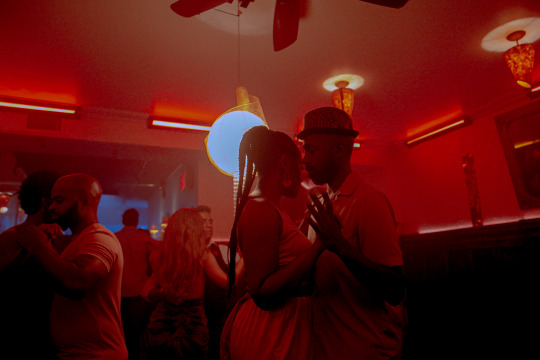
Ntare Guma Mbaho Mwine and Nana Mensah in ‘Farewell Amor’. / Photo courtesy IFC Films
The film’s triptych structure emerged after Msangi spent months grappling with how to create a feature-length screenplay out of her original short film. “Having just come off of the short, I was focusing on Walter’s story. But [I] didn’t think that was the most original story I could tell,” she says. “And then, out of indecision between whether I should make it Walter’s or Sylvia’s story, I decided to just do both. Initially it was two perspectives that I was looking at. But I realized that Esther’s story was really the linchpin for both of their stories, and it wouldn’t make sense not to have hers.”
Giving Walter, Esther and Sylvia their own chapters makes Farewell Amor a stronger film than if it had followed a singular, traditional protagonist. Extreme conservatism in one chapter is revealed as a desire to avoid pain in another; one character’s cramped living room is another’s space to dance freely. Writing on Letterboxd, Tabby points out how the three-part narrative structure grants meaningful subjectivity to characters who deserve it: “It’s so easy for Westernized perspectives to steamroll over films that deal in cultural disparities and thematics, but Farewell Amor takes important steps in showing all sides of the story,” she writes. “It was refreshing to see [the characters] each given the space to exist.”
This layering of voices happens in the camerawork, too. Each section of the narrative is marked with a visual language of its own, complete with specific color palettes and cinematographic techniques. Msangi thinks fondly about the work she put in with cinematographer Bruce Francis Cole to make the chapters distinct. “For Walter’s, it’s sort of a slow cinema, where there’s a lot of still framing. It’s almost like he’s stuck, you know? Stuck in the frame between two surfaces, two hard surfaces, a window frame, a door frame. And in Sylvia’s, we wanted to have it reflect her livelihood, her restlessness. All handheld cameras, all movement. And then for Esther, she’s very observant. She’s been taking everything in, almost in an investigative style, but also a little bit romantic. She’s romanticized this setup, so a lot of close shots, a lot of soft lighting.”
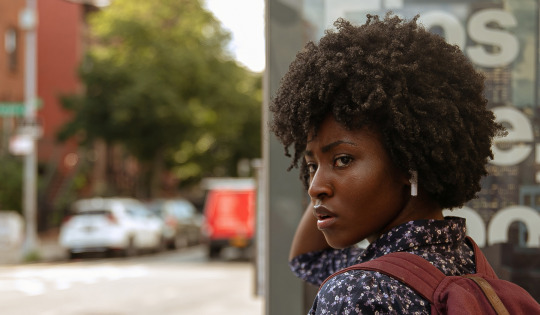
Jayme Lawson as Sylvia in ‘Farewell Amor’. / Photo courtesy IFC Films
Music gives Farewell Amor a cohesion across the different storylines. “Music is, for these characters in particular, and for me, kind of a third language,” Msangi says. “It gives you a glimpse under the covers, what’s under the sheets.” The soundtrack underscores strong performances from Mwine, Jah and Lawson, lending depth to their quietude and vibrance to their movement. Msangi also notes how sound became a cornerstone of her collaboration with the actors: “As I was writing from different perspectives, in order to help me get into each character’s skin, I would listen to the music that they would be interested in.” She later shared these playlists with the actors, using the songs to communicate what words couldn’t.
Msangi has a good laugh as she tries to think about the major films that inspired her to become a filmmaker. “You know, I don’t have that. Well, I do have that, but not for the reasons that most of my film peers have,” she says. Growing up in East Africa in the ’80s and ’90s, little to none of the programming on television was local. What did kids watch instead? “We watched Rambo for probably ten years straight, and then Rambo knockoffs for another ten years after that. I decided to become a filmmaker because of horrible Rambo knockoff films.”
“I grew up surrounded by such colorful and delightful and interesting and funny people,” Msangi says. “And none of that was reflected anywhere in the media.” As she grew older, she sought out African films she couldn’t access in her youth. Now, they’re some of her highest recommendations. Ousmane Sembène is the first African director whose filmography she ever got the chance to dive into. Sembène’s 50-year career has garnered him the affectionate title of ‘Father of African film’ among many critics and scholars, who laud him for his dramas, including Black Girl and Camp de Thiaroye. Msangi, however, finds herself taken with his unique sense of humor. She has also been inspired by Safi Faye, another Senegalese director, who became the first sub-Saharan African woman to attain commercial distribution in 1975—and whose film Mossane portrays sexual intimacy with an openness Msangi hadn’t seen elsewhere.

Writer-director Ekwa Msangi. / Photo courtesy IFC Films
In Farewell Amor, Sylvia’s chapter reads like a compacted coming-of-age film. Msangi points to South African director Darrell James Roodt’s Sarafina! as an influence in that regard. “It was showing for two weeks in Nairobi, and I lined up for four hours to watch,” she says about the film, a drama about youth involvement in the 1976 Soweto uprising. “Even though it’s from a different part of the continent, I’d never seen young African teenagers on a screen before.” More recently, she has loved 2011 TIFF breakout and Oscar contender Death for Sale by Moroccan director Faouzi Bensaïdi, and Radha Blank’s The Forty-Year-Old Version is her favorite film of 2020. She’s hopeful about the future of Black American cinema: Ava DuVernay and Ryan Coogler are two of her favorite working directors.
Msangi’s selections are wide in range, but there’s still one thing holding them together: themes of vulnerability, community and celebration of identity, across different decades and genres. In fact, her approach to watching movies isn’t far off from the way she made her own—Farewell Amor maps concurrent experiences of disparate people, and Msangi’s tastes seem driven by the same balance of vastness and specificity.
“I’m a filmmaker who really abhors working on the same kind of story over and over again, the same genre, the same kinds of characters,” she says. “So I’m not going to make my career just telling stories about immigrants or about, you know, their wretched troubles,” she laughs. “I don’t want to do that.”
Msangi’s next project will be an African-American period piece; beyond that, she hopes to make films in several locations: the Caribbean, Europe and all over the African continent. “I really would like to just have a lot of fun with my career. You know? Because it’s a fun and magical industry that we work in! The work that we do in creating these stories and hopes and dreams—we create magic, so it should be fun.”
Related content
Adam Davie’s Black Life on Film list
Shachar’s 20 Films by Black Directors 2021 Challenge
Screenpaige’s list of Black Women in Film
Follow Selome on Letterboxd
‘Farewell Amor’ is out now in select theaters and on demand through IFC.
#ekwa msangi#jayme lawson#farewell amor#african cinema#black filmmaker#black director#directed by women#52 films by women#female director#black woman director#american film#drama#romance#dance film#angolan cinema#angola#letterboxd
33 notes
·
View notes
Photo





“When I returned to this city, my back never laid down again. Luanda teaches you how to sleep while sitting.“
Ar condicionado // Air Conditioner (2020) dir. Fradique
87 notes
·
View notes
Text

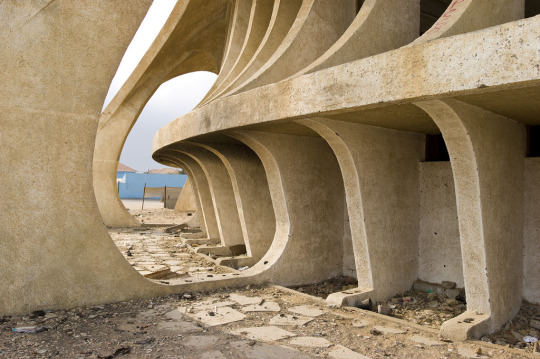


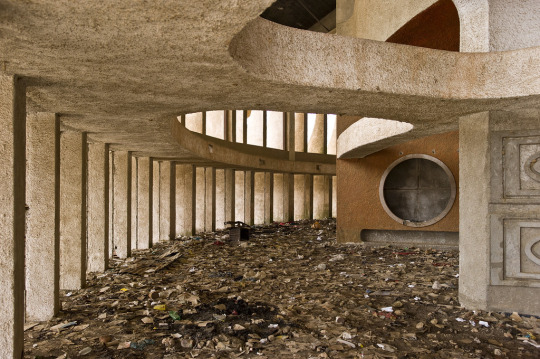
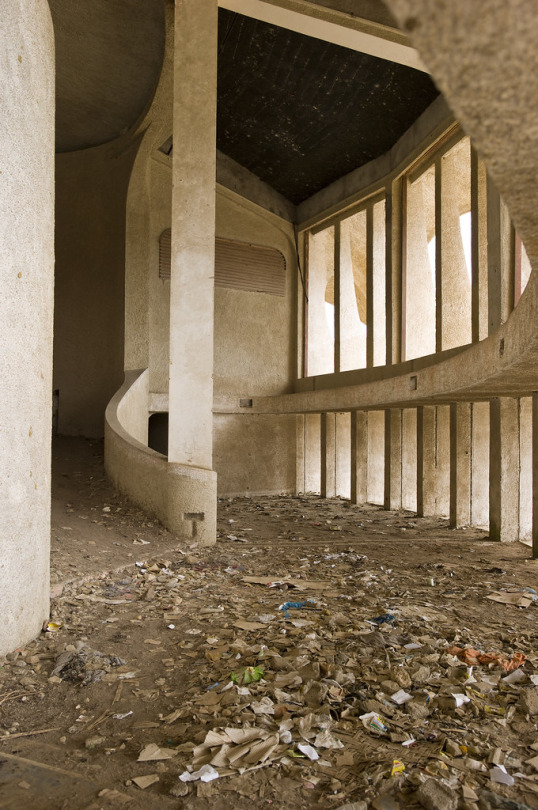

Abandoned theatre in Namibe, Angola.
#angola#abandoned#theatre#trespasser#deserted#vacant#angolan#vacancy#architecture#Architect#black history matters#black history month#black excellence#black exceptionalism#black culture#portuguese#precolonial#post colonial#independent#cinema#photography#goethe#Angolan cinemas
158 notes
·
View notes
Photo

[77] Sambizanga (1972, dir. Sarah Maldoror)
Maldoror’s vital film was made for practical purposes—to document the struggles of the Angolan War of Independence, and the widespread imprisonment and torture of members of the MPLA, at a time when the war against Portugese colonialists was by no means over. With its cast of non-professionals and its absence of visual flourish, Maldoror’s film emerges from and speaks to its circumstances: functional film-making, which doesn’t mean a suspension of ‘quality’ for the contextual, but which makes a strong claim for a mode of cinema that cannot be disentangled from ‘context’, in which form and function match. The film is neither the exposée of neo-realism nor the humanist of ‘poetic realism’, but something entirely its own. The scenario is simple, but has its heart the willed obscurity of a colonial regime who lock away and murder those who challenge them in secret: Domingos, an MPLA militant, is abruptly kidnapped by colonial authorities in a horrific dawn raid of the village; his wife Maria walks from prison to prison, and the film follows her journey, and that of a network of clandestine militants who seek to obtain information on Domingos’ location while themselves remaining ever-careful to avoid exposure. It’s a woman—Maria—and an old man and a young boy—the pair who watch the prison for those who have been secretly deposited there—who form the central points of identification, and while a superficial viewing might suggest that the film reinforces normative gender roles—Maria’s entire focus is on her husband, rendering her in that sense secondary to a political struggle figured as male—that would miss the point. Maria’s grief and uncertainty is genuine, her task is practical: screaming Domingo’s name outside the prison is a practical, political act, as well as a raw welling-up of grief. And the collective network which seeks to aid her, and which can only emerge through mediated forms of communication, the slow process of connection, the discovery of information piece by piece, involves men, women and children, suggests a model of the society that might emerge once the struggle is one, eventually coming into focus in the closing performance of song, a public statement of solidarity and resolve, a joyful memorial for the dead. Made ten years after the events it describes the film is able to close with end titles that note the progress such struggle ensured, even if that struggle has by no means by entirely won. Though Domingos dies, Maria’s persistence, along with that of the network of other militants who receive the news of his death, and who will soon go on to storm the prison, suggest qualities of survival and defiance that assume both a personal and a collective level. A luta continua.
8 notes
·
View notes
Text
0 notes
Photo

[#FILMFESTIVAL #BLACKFILM] Independência
Part of BAMcinématek series New Voices in Black Cinema
Directed by Mario Bastos | 2016
Friday, April 28 | 2pm
Peter Jay Sharp Building | BAM Rose Cinemas | 30 Lafayette Brooklyn, NY
Admission $14 Members | $7 (Free for Level 4 and above)
For showtimes and tickets, visit bam.org/film/2017/independencia
This powerful, evocative documentary about the Angolan struggle for independence brings together the stories of frontline fighters, political prisoners, and the resistance movement against colonial government. Constructed from a vast archive of documentary footage from the period, Independência brings to light untold events and figures from an important anti-colonialist fight.
---
New Voices in Black Cinema returns for the seventh year, with narratives, documentaries, and shorts that examine the black experience in America and around the world. From international voices to films made in Brooklyn to new black classics, New Voices in Black Cinema brings together urgent stories that need to be told.
Presented in partnership with ActNow Foundation. Since its founding in 2005, the ActNow Foundation has been a production company and advocate for diverse, independent filmmakers and playwrights interested in producing work reflecting the infinite range of African-American and Latino experiences across the globe. ActNow hosts regular events in Brooklyn to showcase the best in independent theater and film. Additionally, they are dedicated to fostering the growth of New York's brightest and most talented through regular panels, speakers, and workshops.
#film#film festival#Independência#black film#New Voices in Black Cinema#BAMcinématek#BAM Rose Cinemas#brooklyn#documentary#Angolan independence#ActNow Foundation
0 notes
Text
Netflix to show first Angolan feature film
New Post has been published on http://khalilhumam.com/netflix-to-show-first-angolan-feature-film/
Netflix to show first Angolan feature film
Dias Santana is 80% an Angolan production and 20% South African
Netflix advertisement for the movie Santana, to be premiered on 28 August. Screengrab. Image text: “I want Dias Santana and his brother dead”
From August 28, an Angolan production will appear for the first time in Netflix's catalogue. It is the feature film “Dias Santana”, made jointly with South Africa.
O filme ‘Santana’, uma co-produção entre Angola e a África do Sul, de Maradona Dias dos Santos e Chris Roland, que se estreou nos cinemas em 2015 com o título ‘Dias Santana’, vai estar disponível no Netflix no dia 28 de Agosto.#NovoJornal #Angolahttps://t.co/gVhp4JFHWA — Novo Jornal (@novojornalAO) August 17, 2020
The film “Santana”, a co-production between Angola and South Africa, by Maradona Dias dos Santos and Chris Roland, which premiered in cinemas in 2015 with the title “Dias Santana”, will be available on Netflix on 28 August
The film, which was shown at the Cannes Film Festival in 2015, tells the story of two brothers, a general and a police officer, who discover the identity of their parents’ killer from decades before. According to the outlet Observador, the film was produced by Giant Sables Media of Angola and Zen HQ Films of South Africa. The Angolan producer of the film, Jeremias Didalewa, posted a thankful message on his Instagram profile for having managed to close the deal with the platform:
Malta, amigos e compatriotas. Conseguimos fechar o deal com a Netflix. Teremos o filme “DIAS SANTANA” primeiro filme Angolano na Netflix. Um filme, com uma produção Angolana 80%/Sul Africana 20%. História de uma família Angolana, que começa em Angola e termina na África do Sul. Com vários actores nacionais e internacionais.
Guys, friends and compatriots. We managed to close the deal with Netflix. We will have the film “DIAS SANTANA” the first Angolan film on Netflix. A film, with a production 80 percent Angolan and 20 percent South African. The story of an Angolan family, which begins in Angola and ends in South Africa. With several national and international actors.
The premiere of the Angolan film comes one month after the first Mozambique film also appeared in the Netflix catalogue.
Written by Dércio Tsandzana Translated by Liam Anderson · · View original post [pt] · comments (0)
Donate · Share this: twitter facebook reddit
0 notes
Link
Gender: Female
Origin: Arabic
Meaning: Night, Black
1. Meaning of the name Leila
It is used in England starting with the poem "The Giaour" by George Byon (1813).
Leila's name is the name of a girl in Arabic, Persian origin meaning "night". Leila was popularized in the West by the poet Byron, who used it in the poem Don Juan for a ten-year-old Turkish girl.
Leila also appeared as a fairy in Gilbert & Sullivan's Iolanthe opera. Obsessive Leila has been chosen by celebrities like Al Roker and Greta Scacchi and Vincent D'Onofrio. While Leila has tried to appear on the list of the top 1,000 people in the United States since its founding in 1880, the Layla phonetic form is now much higher on the list in the US.
And parents attracted to girls’ names with the double l sound will find that most examples -- from Leila to Lila to Lily and Lillian and Lilith-- are zooming up the charts and, while classics, are bordering on trendiness. Another alternative is Lelia, a Latin name used in Roman times.
2. Variation of the name "Leila"
Lyla:
The name Lyla is a girl's name of Arabic origin meaning "night". Lyla is a fast-rising variation of Lila. Although the Lyla spelling helps clarify the name's pronunciation, we prefer the original Lila. Laila, Layla, and Leila are all further variations on the same theme.
Lailah:
Lailah is a more complex version of Laila, likely inspired by Layla (Leila). Finally, Arabic, derived from leila / laymus, means that nights Arabs will use this name for their daughters in a convention describing the quality or personality of the baby; so it means dark beauties who are born at night.
The name has been used since medieval times to be inspired by the true Arabic legend of Islam Qays and Laylaien - an unrequited love story. These young virgin lovers fell so deeply in love that they were barely able to contain their devotion.
Causing quite the scandal in their community, Quys was instantly denied Layla’s hand in marriage and kept from seeing her. As a result, he fled the tribe, wandering in wild love poems about his beloved Layla, and eventually fell into insanity before finally dying from death.
It is more commonly thought of as an internationally adopted name at this point as evidenced by the growing number of spelling variations: Layla, Laila, Laylah and Lailah for instance.
The variant of Leila is perhaps the oldest in the English-speaking world, introduced by Lord Byron in the early 19th century as a character in his poems “The Giaour” (1813) and “Don Juan” (1819).
In some Hebrew translations, Lailah was a night angel appointed to assist Abraham (also shared her name with the Hebrew word for the night, לל) . In another Jewish folklore, Lailah was the opposite of Lilith (the night owl of the Muslims);
Lailah picks babies 'newborn souls from the Garden of Eden and takes them into mothers' wombs. Just before they were born, she hit the baby's upper lip (philtrum) to erase the memory of creativity. A maternal symbol, Lailah watches over the souls as a guardian angel.
3. Top 3 Famous Person Named Leila
Leila Arcieri:
Leila Carmelita Arcieri (born December 18, 1973) is an American actress, model and businesswoman. She was Miss San Francisco in the 1997 Miss California pageant and has appeared in many films such as XXX, Wild Things 2 and Daddy Day Care. Arcieri is the founder and president of the natural sweetener brand STIR Sweetener.
Leila Hatami:
Leila Hatami (Persian: لیلا حاتمی Leylā Hātamī; born October 1, 1972) is an Iranian actress and director. She is known for her work in Iranian cinema, including her performance in the Academy Award-winning film A Separation, for which she won the Silver Bear Award for Best Actress at the Berlin Film Festival.
Leila Lopes:
Leila Luliana da Costa Vieira Lopes (born February 26, 1986) is an Angolan actress, TV host, model and an Angolan beauty queen who won the title of Miss Universe 2011.
More ideas for you: Julianna Name Meaning
From : https://wikitopx.com/name-meanings/leila-name-meaing-714939.html
0 notes
Text
At Sundance, a Glorious Diversity of Voices Breaks Through
PARK CITY, Utah — A runaway bride, wildly rambunctious women and two quietly resolute girls — the Sundance Film Festival is one movie celebration where the so-called second sex consistently comes out on top. Now in its 36th year, the festival has long made room for female filmmakers even when there weren’t all that many. In 1985, its inaugural year, it presented 85 movies, 10 from female directors, about half non-Americans like Lina Wertmüller, one of the few such filmmakers on anyone’s radar back then. Of this year’s 128 features, nearly half are from women. (The festival ends Sunday.)
These numbers are impressive; the movies even more so. At some events, female filmmakers sometimes seem to have been invited simply to check a box, a practice that, however well-intentioned, inevitably suggests that women are second-class talent. This year’s Sundance, by contrast, underscores that when women receive real opportunities — serious money and institutional support — the pool of work expands, bringing new stories, styles and worldviews. For the 2020 edition, you didn’t need to dig to find female talent, make excuses for substandard work or politely yawn through another worthy endeavor. It was right on the screen, blissful and unbound.
In the case of the very different documentaries “Time” and “Saudi Runaway,” the desire to make movies isn’t simply about having a say — getting the chance to pick up a camera and share your vision with the world freely — it is also a matter of life itself. Each documentary centers on an extraordinarily gutsy woman who put her everyday existence on camera, detailing her days and nights in intimate, pointillist detail much like a diarist. Each woman subsequently handed over what she had shot to a female director, who then shaped the material, turning self-expression into collective vision.
One of the most critically admired titles at the festival, Garrett Bradley’s “Time” tells the story of Fox Rich, a Louisiana activist, family woman extraordinaire and impressively dedicated memoirist. (The movie is a coproduction of The New York Times.) Processed in black-and-white, it tracks Rich over her decade-plus efforts to support her six sons and find her sense of a whole self all while advocating for the release of her husband from a punishing 60-year prison sentence. Using both original material and a trove of vivid home videos that Rich shot herself, Bradley creates a portrait of a woman that exponentially expands into a complex chronicle of a marriage, a family, a community and finally a country.
“Saudi Runaway” is a starkly complementary story of incarceration, liberation and self-determination. Directed by the Swiss-German filmmaker Susanne Regina Meures, “Runaway” is the nail-biting chronicle of a fearless young Saudi — known only as Muna — as she covertly plans to leave the country for good. Using a couple of smartphones, Muna clandestinely serves as her own dauntless cinematographer, shooting herself, her family and, in fugitive glimpses, the larger world. It’s a perilous activity given women’s traditionally subordinate status there, and transforms selfie-style narcissism into radical resistance. (The movie was shot before new rights were granted to women.) As her plans solidify, “Saudi Runaway” progressively resembles a thriller, one filled with harrowingly close calls and an exhilarating countdown.
The increased presence of women behind the camera at Sundance marks a crucial shift, given that not long ago the more celebrated women at the event were performers like Parker Posey and Lili Taylor (here playing a mom in the clichéd “The Evening Hour”). For years, women’s roles at this festival seemed best symbolized by the “Sundance It Girl,” a dubious honor that stretches at least back to Andie MacDowell, a star of “sex, lies, and videotape.” That’s the 1989 Steven Soderbergh game-changer that helped kick-start an era in indie cinema, one that often proved as sexist as Hollywood and just as blindingly white.
The number of African-American female filmmakers in this year’s lineup offered further evidence of what seems to be a significant, perhaps lasting sea change. A perfect example, and a highlight of the U.S. dramatic competition, “The 40-Year-Old Version” hasn’t secured distribution but deserves the widest release possible. Written and directed by the playwright Radha Blank — who also stars — it traces the rebirth of an artist with lacerating insight, a great deal of warmth and terrific comic timing. It was shot in black-and-white, a visual choice that nods to iconic New York films, most instructively from Woody Allen and Spike Lee. Here, Blank makes the city and its promise her own from the first scene to a last expressive burst of rapturous color.
The colors pop bright and hard in “Zola,” a kaleidoscopically hued, periodically discomforting, comically ribald adventure from Janicza Bravo (“Lemon”). Narrated largely in flashback by the title character (played by the game newcomer Taylour Paige), the story unwinds in extended flashback, with Zola detailing an improbable, ridiculous, often funny and sometimes dangerous adventure involving another woman, Jessica (the reliably bold Riley Keough), a stripper with execrable judgment. Bravo skims the surface with impressive control and a great deal of visual wit and, every so often — as with a shot of a Confederate flag — gestures toward deeper, unrealized ideas. (The movie is based on an epic, rather more grim Twitter thread.)
A different odyssey is undertaken in Eliza Hittman’s “Never Rarely Sometimes Always,” which tracks a teenager, Autumn (Sidney Flanigan), who travels to New York City to obtain an abortion. With unforced realism, a minimum of music, spare dialogue and no histrionics, Hittman nicely sketches in Autumn’s home life — her mom dresses the kids and the dad both — but mostly concentrates on Autumn and her relationship with the cousin (Talia Ryder) who accompanies her. By refusing to grandstand, Hittman, who wrote and directed, has made the most moving, cleareyed American fiction movie about a woman’s right to abortion since “Fast Times at Ridgemont High” (1982).
Kirby Dick and Amy Ziering’s much-publicized documentary “On the Record” looks at several women — notably Drew Dixon, a music executive — who have accused the music giant Russell Simmons of sexual misconduct (allegations he denies). Much of the movie includes interviews, including with writers like Joan Morgan, who puts the personal into larger context. The women on camera make their case strongly; they also legitimize the documentary, which had come to the festival tainted by criticism from Oprah Winfrey, a former executive producer, who cut ties to it, citing creative differences. The filmmakers make some unfortunate choices, particularly in some staged scenes, but the movie belongs to these women, whose truth feels unassailable.
Time and again at the festival, you saw real diversity in both the snowy streets and in the theaters, where the American experience in all its complexity was being told and retold in movie after movie. Proof of that came in two of my favorite selections from the 2020 edition, the dramas “Minari” and “Farewell Amor.” To a degree, we have seen these stories before or at least think that we have: each turns on a hardworking family of ostensible outsiders trying to find their place in a not always welcoming country.
In “Minari” (written and directed by Lee Isaac Chung), the family is Korean-American and moves from California to Arkansas to pursue the father’s dream of farming vegetables. In “Farewell Amor” (from the writer-director Ekwa Msangi), an Angolan refugee brings his wife and daughter to America after a long, anguished separation, moving them into a crowded Brooklyn apartment. Each movie solicits well-earned tears and turns on a profound crisis that can only be solved when the family pulls together, unity that works as a welcome and, in its underlying optimism, deeply moving metaphor for life in what too often feels like the Disunited States of America.
from WordPress https://mastcomm.com/at-sundance-a-glorious-diversity-of-voices-breaks-through/
0 notes
Photo






Independência, Marío Bastos / Angola, 2015
Comprised of hundreds of interviews with frontline fighters, political prisoners, and the resistance movement against the colonial government, alongside a vast archive of documentary footage, Independência brings to light untold events and figures from an important anti-colonialist fight. From 1961 to 1974, the war in Angola spread from the bush areas in the North and Cabinda to the flood plains in the East, involving both the guerrillas and those that supported them. Through a combination of military operations and economic and legal reforms, Portugal managed to prolong a war it could not win.
37 notes
·
View notes
Text
Luanda: A Truly Picturesque City
Angola’s capital city Luanda is often referred to as the most expensive city in the world for the ex-pats. Luanda is a city located in the South-West of Africa on the coast of the Atlantic Ocean, near the mouth of the Cuangi River. The city is built around the bay and is in the shape of a semi-circle. People in Luanda speak mostly Portuguese.
Luanda was once a place of conflict but has reinvented itself as a peaceful, stable modern city. The city has been restored which was once historically a center for trade, culture, and commerce. Today, you’ll find a luxury beach party scene, fine dining and shopping in a lush, and welcoming.
You will find beautiful architecture to a museum to relaxing beaches Luanda offers numerous diverse attractions and entertainment options. Luanda doesn’t have much relating to museums, cinemas, and a theatre, so eating out is a big pastime. Mostly restaurants in Luanda are filled with ex-pats. Places like Kintal Da Tia Guida attract mainly Angolans and entire families on weekends, creating a boisterous festive atmosphere.
Let’s Take a Look at the Best Things to Do and See In Luanda:
The Palacio de Ferro (Iron Palace) is a magnificent palace built by world-renowned architect Gustave Eiffel the builder who built the world-famous Eiffel Tower in Paris and the Statue of Liberty in New York. The Iron Palace is a stunning piece of architecture.
Ilha de Luanda (island of Luanda) it’s not an island but a small peninsula, it’s has some good beaches, restaurants, and bars. If you want to enjoy nightlife and party then this place is a must to visit.
Tourist Attraction in the Outskirts of Luanda:
Miradourous da Lua is a beautiful landscape created by wind and water. This landscape resembles a moon surface. In other words, it is also known as Moon Valley point. Miradouro da Lua was formed by a cliff with sharp pinnacles that have been eroded from the wind and the sea. This gives it a moon-like surface.
Kissama National Park is two hrs distance from the city of Luanda. This National Park is also called as Quissama National Park. The plants in Kissama are very beautiful with huge Baobab trees. Some mammals in the park include the forest buffalo, eland, antelope, waterbuck and bush bucks among others.
Accommodation: one can stay at the thatched chalets on the banks of Cuanza River with self- contained accommodation facilities at Pousada Caua. This lodge also offers activities like fishing, beach walks, river cruises, bird watching adventures, and others.
Kalandula falls is one of the largest waterfalls by volume in Africa. It is a must-visit attraction whilst you are in the capital. Kalandula Falls is a broad horseshoe-shaped waterfall. It is termed as the awesome power of nature. The best views of the falls come from its base.
Outdoor Activities in Luanda:
In Luanda, there are interesting and beautiful savannahs that will impress wildlife lovers. Jeep safaris are available for travelers where they come across leopards, elephants, lions, giraffes, antelopes, and various kinds of monkeys. Tourists can go walking all over and admire at the majestic trees that have adapted to the hot climate.
Beaches:
Among all the beaches of Luanda Mussulo, Ile, Belas, and corymbia are popular beaches. There is a small palm island, which amazes visitors by its beauty.
The beach Mussulo is a good place to get away from the city. The water is warm, and it is relaxing. Tourists can enjoy the quad bikes and boating. So there is plenty to do there. It’s great to go with a group of friends or with the family. Shacks and restaurants are lined along the beach as well as a few hotels and resorts. This place is perfect for a day trip or a romantic overnight getaway.
Go Surfing: Cabo Ledo is the world-famous surfing beach in Luanda. It is a great place for surfers who have just begins to surf. The beach is also available with some quaint bungalows. It is also a great place to camp under the starlit nights.
Entertainment in Luanda:
Best places to meet girls in Luanda and dating guide: this is the most expensive city in Africa and most expensive in the world, at least if you want to enjoy western living standards. The main area for single nightlife is on Ilha De Luanda and along Avenida Murtala Mohamed, Ilha do Cabo and Miramar. All three of these places try to hook up with Luanda girls.
Nightlife: dance the night away at the chic Switch Supper Club which is open on the weekends until 6a.m. Nightlife can be very expensive. Drink some local beers like Cuca or Tigra before you go out to a bar or club if you want to cut down on your cost.
Cuisine: from fine dining to fabulous street food, including mouth-watering fresh seafood dishes, there is a diverse restaurant scene for your taste buds to explore. Loolal Mar sells the best seafood in Luanda. Though the prices are high the tourist enjoys seafood along with an open-air seaside setting.
Shopping: Maianga is the city’s shopping district for locals. Bellas shopping is the country’s first modern mall. It is a great way to escape a hot day. It is a large mall that has eight cinemas, an entertainment area, a food court and over 100 stores. There are also banks and supermarkets within the mall.
Go crafts shopping at the Benfica market selling everything from perfume, ivory, animal skins, colorful pictures to tourist guidebooks and several types of antiques.
When to visit: October to March are the most culturally active months. They include Angola Restaurant week, the Axiluanda Food Festival, Luanda Cocktail Week, Luanda’s anniversary and it’s very own carnival glorious beach weather too.
Climate: Luanda being the seaside capital city of Angola has the perfect climate for a visit at any time of the year.
Luanda being an appealing destination, one must not miss the opportunity to visit this picturesque city.
from The Traveller https://ift.tt/2XGghxs
via IFTTT
from WordPress https://ift.tt/2XGwovb
0 notes